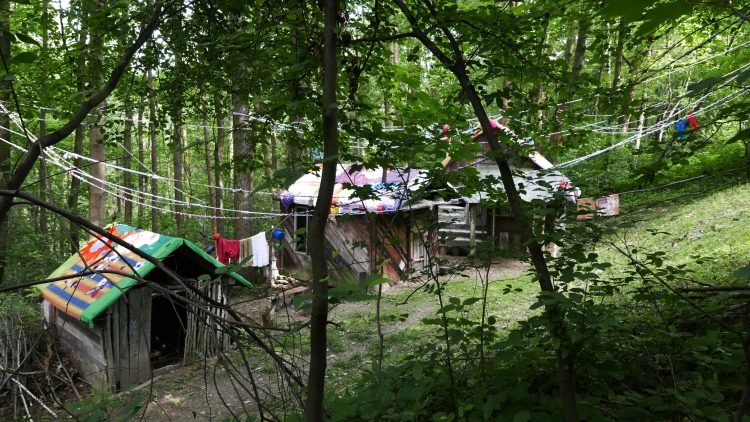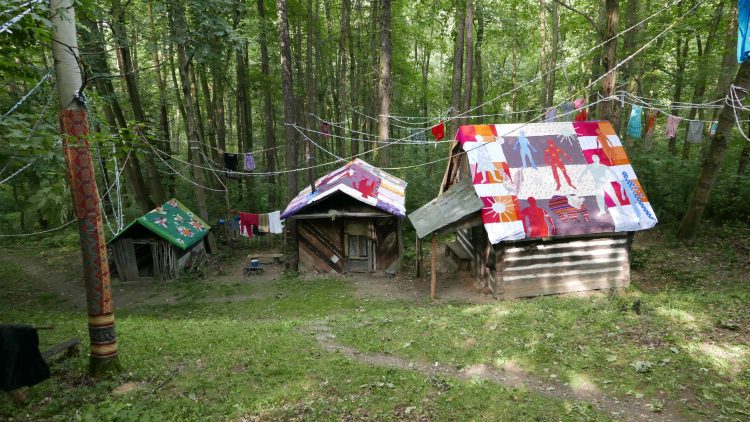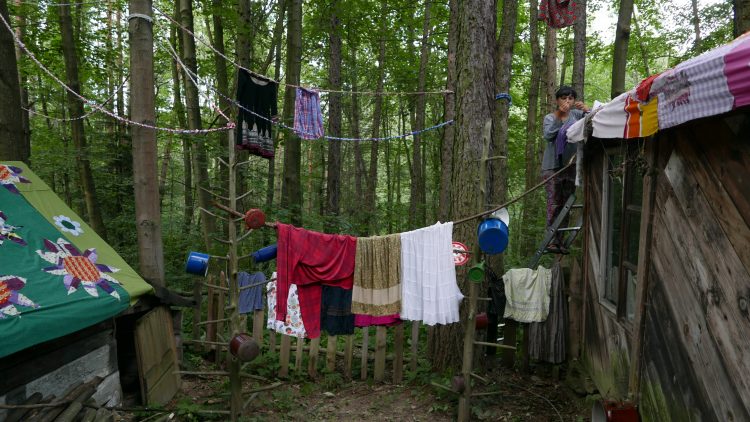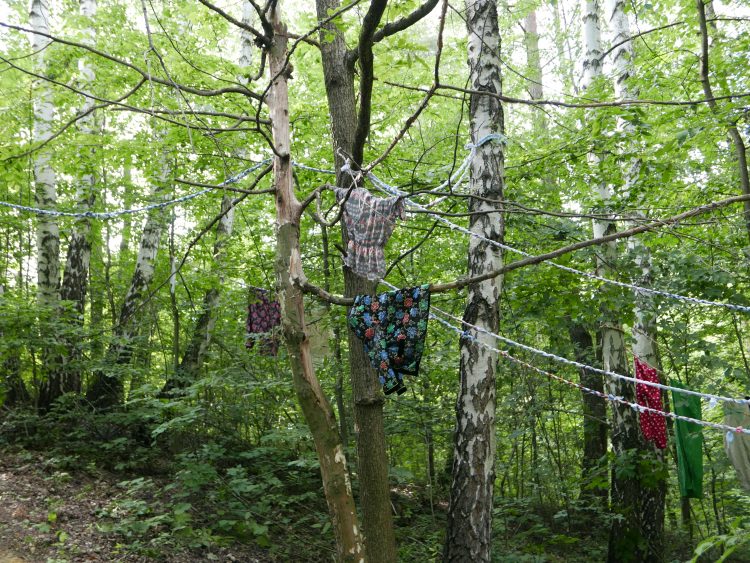Dismantling ethnography, decolonising the museum, flipping the map: Wesiune thana / Place in the Woods by Małgorzata Mirga-Tas

Małgorzata Mirga-Tas: “Wesiune thana”, 2016. Photo: Marcin Tas. Courtesy of the artist.
There is no doubt that for some time now we have been witnessing two cultural processes in Europe, that are simultaneously complementary and competitive. On the one hand, the last decades of the twentieth century and the first decades of the twenty-first century can be characterised as a period of unprecedented growth of interest in the past, history, memory, and heritage. This “European memory complex”, as Sharon Macdonald calls it[1], results in a diverse institutionalisation of history, memory, and heritage discourse. This becomes evident through the numerous and varied institutions created in Europe today, professionally collecting, digitising, exhibiting, and retelling the past and its traces. Among these, certainly, museums occupy a prominent place. On the other hand, this European “memory fever and remembrance epidemic”[2] is accompanied by a self-aware, often bottom-up and non-institutional, critical and revisionist process, a process re-evaluating and rearranging the European “Memoryland”[3], reinterpreting existing and still emerging museum institutions.
I would like to present this process as the decolonisation of museum and memory practices, and interpret it – as Ariella Aïsha Azoulay suggests – as a form of unlearning the existing forms and norms of cultural domination and imperialism.[4] It can be said that this current – generously drawing on postcolonial theory and practice, feminism and queer studies, as well as subaltern studies – has three main goals. First, in the most literal sense, it is a critique of Western museum collections – especially archaeological, ethnographic and anthropological collections created during the time of expansive European colonisation of the global south in early and late modernity – and striving for the restitution and return of musealised cultural heritage. Secondly, it is a theoretical reflection on the exclusionary, elitist, often (intentionally or not) classist and racist practices of museum institutions and traditional European museology. Thirdly, as a cultural practice aimed at greater inclusivity of museum collections and narratives. The previously mentioned decolonisation thus consists of attempts to broaden the museum’s grand narratives, to include the stories of previously excluded groups (e.g., ethnic and sexual minorities, social classes, non-normative groups, and communities situated on the margins of hegemonic communities), as well as critical analysis and reinterpretation of the musealisation of the history of these groups, which – even if they are already of interest to the museum – are often depicted in a stereotypical or even harmful manner.
A good example illustrating these two processes is the functioning of Roma history and heritage within the wider memory complex. Although the Roma, their history and heritage have long been present in museum institutions, the image constructed by these institutions is often a derivative of the imperially-oriented museums of the eighteenth and (especially) nineteenth centuries. As noted by Polish sociologist and researcher of Roma history, Sławomir Kapralski, the ways of seeing the Roma developed by European modernity and its institutions (including museums) are a mixture of condescension and orientalism. The Roma were seen as backward barbarians, incapable of civilisational progress, strangers existing beyond the nation’s life.[5]
In Poland, the institutional musealisation of Roma material heritage began relatively early, around the birth of Polish ethnographic exhibitions. Items relating to the life and works of Roma people appeared already at the first ever Polish ethnographic exhibition, organised in 1880 in Kolomyia, Ukraine.[6] Today, the most significant exhibitions of Roma material heritage and collections can be found in the Ethnographic Museum in Tarnów[7], the Museum of Roma Culture in Warsaw[8], as well as in the Sądecki Ethnographic Park in Nowy Sącz.[9]
In addition to institutionalised museum narratives, in recent years there has, however, emerged a competitive attempt to represent Roma history in Poland. I am thinking of the artistic work of Małgorzata Mirga-Tas, a Roma artist from the Bergitka Roma community, whose voice is one of the most interesting and significant on the contemporary art scene in Poland. My intention with this short text is not to comprehensively describe her art in chronological order. I would rather focus on one project that the artist executed, with me as the curator. Said project is the installation, Wesiune thana (Place in the Woods, 2016), which to me, comprises an essential input in today’s debates about museums, storytelling, and the decolonisation of museum practices and discourse. Wesiune thana is one of several projects created by the artist, the common denominator of which is the creation of a proper artistic counter-narrative – bottom-up, stemming from within the Roma community, and set against the backdrop of top-down museum narratives of Polish ethnography and anthropology. At the same time, the art of Małgorzata Mirga-Tas, especially Wesiune thana, can be read as a decolonisation of Roma history and heritage in Poland and – in the spirit of Ariella Aïsha Azouley – a lesson in unlearning cultural imperialism.

Małgorzata Mirga-Tas: Wesiune thana, 2016. Photo: Marcin Tas. Courtesy of the artist.
The Polish musealisation of Roma material heritage, which began in 1880, is entirely dominated by the ethnographic discourse and ethnographic-anthropological practices dating back to nineteenth-century ethnic and Romani studies. As we know from numerous theoreticians dealing with the discourse and institution of the museum, the process of musealisation itself – essential for the museum practice – each time creates a kind of façade reality: by taking an object out of its socio-political reality, a substitute is constructed, which can at most be considered a hint at reality.[10] What is truly of importance, however, is that those substitutes in ethnographic museums, especially in open-air museums, seek to blur the border between reality and its imitation. This kind of naturalisation of the musealisation process aims to create a “real”, holistic, and coherent vision of the past. The visitors move through time into an unspecified, pre-industrial past. Essentially, viewers are not supposed to notice the museum’s interference in the representation constructed by it[11]; they are led to believe that they are, in fact, communing with reality as it used to be, and not a substitute.

Małgorzata Mirga-Tas: Wesiune thana, 2016. Photo: Marcin Tas. Courtesy of the artist.
The attempt to sell this façade as reality itself, which is characteristic of many open-air museums, is also visible at the Sądecki Ethnographic Park in Nowy Sącz, opened in 1975, where Małgorzata Mirga-Tas implemented her site-specific project in 2016: Wesiune thana, which in Romani means “place in the forest”. The work was created as part of the exhibition pany chłopy chłopy pany [masters peasants peasants masters], which I co-curated, and part of which took place in the open-air museum in Nowy Sącz. The Sądecki Ethnographic Park, like many other Polish open-air museums (e.g., the Museum of Folk Architecture in Sanok, the Museum of the Radom Village in Radom, and the Museum of the Słowińska Village in Kluky), is an open-air regional museum created after World War II during the Polish People’s Republic. This means that it presents rural buildings of a specific region, in this case, the Sądecczyzna. In this way, the museum is like a miniature model frozen in time, prior to the introduction of paved roads, high-voltage power lines, and roofs covered with Eternit panels and sheet metal, etc. The area is divided according to ethnographic knowledge into sectors, corresponding to “real” regions mapped by professional ethnographers. Objects belonging to the “real” ethnic groups inhabiting the former Sądecczyzna region were translocated into these sectors. Construction and architecture attributed by ethnography to the Sądecki Lachs are therefore adjacent to objects from areas inhabited by the Sądecki mountain folk and to the buildings of the Western Pogorzans [Uphillers], which in turn border the houses of the Lemkos. A significant portion of the open-air museum is occupied by buildings erected by the German-speaking population that once inhabited the region, who came here in the eighteenth century.
A separate place in the open-air museum was devoted to Roma buildings initially used by people from the Bergitka Roma group, which the artist herself is also a member of. These are two houses moved in 1980 from Maszkowice, and the reconstruction of a forge belonging to the artist’s family. This building, which comes from Małgorzata Mirga-Tas’s hometown of Czarna Góra, was moved to the museum in 1981.[12]

Małgorzata Mirga-Tas: Wesiune thana, 2016. Photo: Marcin Tas. Courtesy of the artist.
The artist was interested in at least three problems that emerged at the junction of museum and ethnographic discourses. First of all, she was interested in the musealisation of buildings well-known to her, which were moved to the open-air museum when she was only a few years old. Secondly, the artist was intrigued by her own unique position – as a Roma woman and someone coming from a community subjected to musealisation – finding herself at the intersection of being a visitor to the museum, who is the addressee of the museum’s discourse, and at the same time, someone who undergoes musealisation and thus becomes a museum exhibit herself. It is worth noting that from all ethnic groups historically inhabiting the region, only the Roma remain. None of the inhabitants of today’s region would identify themselves in earnest as a Lach or a Pogórzan. The last non-Polonised descendants of German colonists had to leave Poland after World War II, while the Lemkos were displaced from the region after 1947 as part of the “Vistula” operation conducted by the communist government and army. Finally, the location of the Roma buildings in the open-air museum and their relationship to other buildings moved there, as well as to the museum audience, turned out to be fascinating. Roma buildings were located on the sidelines of the main museum exhibition, at a certain distance from it, and the surrounding forest and lush thickets effectively separate them from the well-marked and maintained roads of the museum.
Due to the fact that the artist could not work inside the interiors of the buildings in which there was a museum space arranged and equipped by museologists to give the impression of “real” Roma interiors, Małgorzata Mirga-Tas decided to work outside, dealing with the external façades and roofs of buildings, as well as their immediate surroundings. As a result, she rather created a series of colourful patchwork-emballages, sewn from fabrics and clothing obtained in the artist’s family residential area in Czarna Góra. She used these to cover the roofs of objects in the open-air museum. Additionally, with the help of a spider-like network of installations consisting of a rope woven by women from her immediate family, the artist connected the buildings to the surrounding trees.
The meaning of Małgorzata Mirga-Tas’s work is not unambiguous. The reason for this is the untoward and ironic nature of the project itself. The artist did indeed create a kind of motley, flashy wrapping, but only seemingly succumbing to the stereotypes dominating Polish popular culture and common knowledge of the multi-coloured and “ethnic” dimension of Roma visual and material culture, the most famous exemplification of which are “coloured carts” (wozy kolorowe). This strategic move: subversively exploiting the ambiguity of the colonial mimicry described by Homi K. Bhabha[13], can also be described – quoting Stephen Bann – as a tactic of demystifying the museum façade by means of the “ironic museum”.[14]
The concept of an ironic museum used by the artist in Wesiune thana directly contradicts the already mentioned naturalisation of musealisation present in the open-air museum. Conversely, the ironic museum supports competitive readings of museum exhibits in relation to official museum narratives, and by pointing to itself, it deliberately defines itself as a construct and as only one of many possible ways of presenting and talking about the past.[15] It can be argued that on many levels, by using the potential of the ironic museum, the artist destabilised the open-air museum and the ethnographic and museum discourse, which have long claimed objectivity and “truth” for themselves.
Thanks to the spectacular and eye-catching “motley” artistic intervention, the Roma buildings, which had so far remained on the periphery of the museum’s narrative and were virtually invisible among the thicket, became – for the duration of the exhibition – not only highly visible, but also one of the most popular and most visited by museum guests. At the same time, a situation was created in which the museum audience – not having full knowledge of the artist’s intervention, and in any case not comprehending its extent – was forced to ask questions about the “original” historical substance and its artistic extension, about the status of the objects, their value, their history, the “real” heirs of this material heritage, and criteria justifying the translocation of buildings and exhibits to the museum. In other words, what appeared before the intervention of Małgorzata Mirga-Tas as a natural order of reality, was later exposed to be merely an imitation, simultaneously prompting visitors to ask questions about the current non-museum social reality.
Wesiune thana was a successful example of institutional critique, focused on the attempt to deconstruct the museum’s geo/topography. The location of the Roma buildings from Maszkowice and Czarna Góra actually credibly and correctly recreates the spatial relations in the historical landscape of the Polish countryside between the centrally located peasant farmsteads and the buildings of the Roma community remaining on the margins. Łukasz Bukowiecki, a Polish researcher of the history of open-air museums, notes that “the landscape co-created by architectural objects and their surroundings (e.g., vegetation) is an important, if not the most important, component of the message of open-air museums. Nature is not only the background but also an integral part of the performance and co-determines its assumed totality”.[16]

Małgorzata Mirga-Tas: Wesiune thana, 2016. Photo: Marcin Tas. Courtesy of the artist.
It is with the help of the landscape and such aspects as greenery, roads, and elements of topography shaping the surface, that the mood of the former Polish village, scientifically justified by ethnography, is created.[17] This landscape created by means of geo/topography, however, is a reproduction, repetition, and revision of symbolic – and yet still real – hierarchical spatial relations of power. It is an alienating power of today’s national community, which, like colonial mimicry – divides the world into the familiar and the foreign.[18]
The optical shift of Roma buildings to the centre of the museum narrative, as it occurred in Wesiune thana, does not invalidate the historically justified geo/topography of the former Polish village. However, by highlighting the connections and spatial relations in the museum with the help of ropes stretched between Roma buildings and trees, the work points to the selectivity and arbitrariness of the museum’s restoration of geo/topography. It seems reasonable to ask why the relationship is built upon the spatial dichotomy of centre-periphery and the symbolic division into the familiar and the alien. Why does the discourse and museum practice, in order to adequately reflect the “mood of the former Polish countryside”, not use, for instance, the reproduction of its characteristic audiosphere or its scents and odors, etc.?
The questions posed five years ago by Małgorzata Mirga-Tas about the ways of exhibiting and displaying Roma cultural heritage in Polish museums are still relevant (especially) today. Undermining, unlearning, reversing, and decoding imperialism in the discourse and practice of museums has only just begun in Poland (as well as in Europe and America). Wesiune thana – like any outstanding work of art – was ahead of reality and the discourse on museum decolonisation, before it began in earnest.
Wojciech Szymański
[1] Macdonald, Sharon: Memorylands: Heritage and Identity in Europe Today, Routledge, 2013, p.1.
[2] Ibid., p.3.
[3] Ibid., p.1.
[4] Ariella Aïsha Azoulay: Potential History: Unlearning Imperialism, Verso, 2019, p.10.
[5] Sławomir Kapralski: “Romowie i muzealny grzech pierworodny”, in: Studia Romologica, no. 11, 2018, p.15.
[6] Jan Bujak: Muzealnictwo etnograficzne w Polsce (do roku 1939), Uniwersytet Jagielloński, 1975, p.24.
[7] Adam Bartosz: Katalog zbiorów cyganologicznych Muzeum Okręgowego w Tarnowie, Muzeum Okręgowe w Tarnowie, 2007, pp.5-10.
[8] Andrzej Grzymała-Kazłowski: “Muzeum Kultury Romów w Warszawie”, in: Studia Romologica, no. 11, 2018, pp.97–114.
[9] Bogusława Błażewicz: Ludowe prezentacje. 35 lat sądeckiego skansenu, Muzeum Okręgowe w Nowym Sączu, 2010, p.7.
[10] François Mairesse: “Muzealizacja/Umuzealnienie”, in: Słownik encyklopedyczny muzeologii, eds. A. Desvallées, F. Mairesse, Muzeum Pałacu Króla Jana III w Wilanowie, 2020, p.252.
[11] Łukasz Bukowiecki: Czas przeszły zatrzymany. Kulturowa historia skansenów w Szwecji i Polsce, Campidoglio, 2015, p.34.
[12] Bogusława Błażewicz: Op.cit., p.17.
[13] Homi K. Bhabha: Miejsca kultury, trans.: T. Dobrogoszcz, Wydawnictwo Uniwersytetu Jagiellońskiego, 2010, p.42.
[14] Stephen Bann: “Historical Text and Historical Object: The Poetics of the Musée de Cluny”, in: History and Theory, no. 17, 1978, pp.251–266.
[15] Anke te Heesen: Teoria muzeum, trans.: A. Teperek, ed. A. Ziębińska-Witek, Niemiecki Instytut Historyczny, Wydawnictwo Neriton, 2016, p.24.
[16] Łukasz Bukowiecki: Op.cit., p.33.
[17] Ibid.
[18] Wojciech Szymański: “Małgorzata Mirga-Tas, Wesiune thana, 2016”, in: pany chłopy chłopy pany, [cat.], eds. W. Szymański, M. Ujma, Galeria Sztuki Współczesnej BWA Sokół w Nowym Sączu, 2016, p.166.
Previous Blog Entry
Next Blog Entry

[…] Next Blog Entry […]
[…] Previous Blog Entry […]
[…] Wesiune thana / Place in the Woods by Małgorzata Mirga-Tas” (https://eriac.org/dismantling-ethnography-decolonising-the-museum-flipping-the-map-wesiune-thana-pla…). […]
Quite interesting. I really loved going to your website. Many thanks.